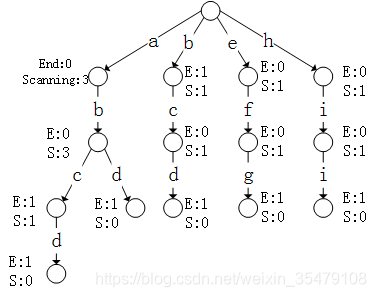1 字典树(前缀树)
前缀树是N叉树 的一种特殊形式。通常来说,一个前缀树是用来存储字符串的。前缀树的每一个节点代表一个字符串(前缀) 。每一个节点会有多个子节点,通往不同子节点的路径上有着不同的字符。子节点代表的字符串是由节点本身的原始字符串,以及通往该子节点路径上所有的字符组成的。
对于前缀树,根节点不包含信息,路径保持字符,结点存两个值:pass 和 end。
bash
1. Trie() 初始化前缀树对象
2. void insert(string word) 将字符串word插入前缀树之中
3. int search(string word) 返回前缀树中字符串word的实例个数
4. int prefixNumber(string prefix) 返回前缀树中以prefix为前缀的字符串个数
5. void delete(string word) 从前缀树中移出字符串word(1) 从类的角度进行描述和实现(哈希)
数据结构的实现,采用struct来构建Trie的节点
cpp
// 字典树节点结构
struct TrieNode {
int pass; // 有多少个单词经过此节点
int end; // 有多少个单词以此节点结尾
std::unordered_map<char, TrieNode*> nexts; // 子节点映射表
TrieNode() : pass(0), end(0) {}
~TrieNode() {
// 递归删除所有子节点,防止内存泄漏
for (auto& pair : nexts) {
delete pair.second;
}
}
};
TrieNode* root; // 根节点将字符串word插入前缀树之中
cpp
void insert(const std::string& word) {
if (word.empty()) return;
TrieNode* node = root;
node->pass++;
for (char c : word) {
if (node->nexts.find(c) == node->nexts.end()) {
node->nexts[c] = new TrieNode();
}
node = node->nexts[c];
node->pass++;
}
node->end++;
}搜索字符串在树中出现的次数
cpp
int countWordsEqualTo(const std::string& word) const {
const TrieNode* node = root;
// 利用哈希表来寻找下一个节点
for (char c : word) {
auto it = node->nexts.find(c);
if (it == node->nexts.end()) {
return 0;
}
node = it->second;
}
return node->end;
}返回前缀树中以prefix为前缀的字符串个数
cpp
int countWordsStartingWith(const std::string& prefix) const {
const TrieNode* node = root;
for (char c : prefix) {
auto it = node->nexts.find(c);
if (it == node->nexts.end()) {
return 0;
}
node = it->second;
}
return node->pass;
}从前缀树中删除指定单词
cpp
void erase(const std::string& word) {
if (word.empty() || countWordsEqualTo(word) == 0) return;
TrieNode* node = root;
node->pass--; // root中的pass表示有多少个word
for (char c : word) {
TrieNode* next = node->nexts[c];
if (--next->pass == 0) {
// 递归删除子树
delete next;
node->nexts.erase(c);
return;
}
node = next;
}
node->end--;
}最终代码实现
cpp
#include <string>
#include <unordered_map>
class Trie {
private:
// 字典树节点结构
struct TrieNode {
int pass; // 有多少个单词经过此节点
int end; // 有多少个单词以此节点结尾
std::unordered_map<char, TrieNode*> nexts; // 子节点映射表
TrieNode() : pass(0), end(0) {}
~TrieNode() {
// 递归删除所有子节点,防止内存泄漏
for (auto& pair : nexts) {
delete pair.second;
}
}
};
TrieNode* root; // 根节点
public:
// 构造函数
Trie() : root(new TrieNode()) {}
// 析构函数
~Trie() {
delete root;
}
// 插入单词到字典树
void insert(const std::string& word) {
if (word.empty()) return;
TrieNode* node = root;
node->pass++;
for (char c : word) {
if (node->nexts.find(c) == node->nexts.end()) {
node->nexts[c] = new TrieNode();
}
node = node->nexts[c];
node->pass++;
}
node->end++;
}
// 从字典树中删除单词
void erase(const std::string& word) {
if (word.empty() || countWordsEqualTo(word) == 0) return;
TrieNode* node = root;
node->pass--;
for (char c : word) {
TrieNode* next = node->nexts[c];
if (--next->pass == 0) {
// 递归删除子树
delete next;
node->nexts.erase(c);
return;
}
node = next;
}
node->end--;
}
// 统计完全匹配的单词数量
int countWordsEqualTo(const std::string& word) const {
const TrieNode* node = root;
for (char c : word) {
auto it = node->nexts.find(c);
if (it == node->nexts.end()) {
return 0;
}
node = it->second;
}
return node->end;
}
// 统计以prefix为前缀的单词数量
int countWordsStartingWith(const std::string& prefix) const {
const TrieNode* node = root;
for (char c : prefix) {
auto it = node->nexts.find(c);
if (it == node->nexts.end()) {
return 0;
}
node = it->second;
}
return node->pass;
}
};2 从数组的角度进行实现
cpp
#include <string>
#include <cstring>
class Trie {
private:
static const int MAXN = 150001; // 最大节点数,可根据数据量调整
int tree[MAXN][26]; // 存储子节点的索引
int end[MAXN]; // 标记该节点是否为单词结尾
int pass[MAXN]; // 记录经过该节点的单词数量
int cnt; // 当前使用的节点数量
public:
// 初始化字典树
Trie() {
build();
}
// 重置字典树
void build() {
cnt = 1;
memset(tree, 0, sizeof(tree));
memset(end, 0, sizeof(end));
memset(pass, 0, sizeof(pass));
}
// 插入单词到字典树
void insert(const std::string& word) {
if (word.empty()) return;
int cur = 1; // 从根节点开始(索引1)
pass[cur]++; // 根节点pass值增加
for (char c : word) {
int path = c - 'a'; // 计算字符对应的路径索引(0-25)
if (tree[cur][path] == 0) {
tree[cur][path] = ++cnt; // 分配新节点
}
cur = tree[cur][path];
pass[cur]++; // 经过当前节点的单词数+1
}
end[cur]++; // 单词结尾标记+1
}
// 统计完全匹配的单词数量
int search(const std::string& word) const {
if (word.empty()) return 0;
int cur = 1;
for (char c : word) {
int path = c - 'a';
if (tree[cur][path] == 0) {
return 0; // 路径不存在,单词不存在
}
cur = tree[cur][path];
}
return end[cur]; // 返回单词结尾标记值
}
// 统计以prefix为前缀的单词数量
int prefixNumber(const std::string& prefix) const {
if (prefix.empty()) return 0;
int cur = 1;
for (char c : prefix) {
int path = c - 'a';
if (tree[cur][path] == 0) {
return 0; // 前缀路径不存在
}
cur = tree[cur][path];
}
return pass[cur]; // 返回经过该节点的单词数
}
// 从字典树中删除单词
void deleteWord(const std::string& word) {
if (word.empty() || search(word) == 0) return;
int cur = 1;
pass[cur]--; // 根节点pass值减1
for (char c : word) {
int path = c - 'a';
int next = tree[cur][path];
if (--pass[next] == 0) {
tree[cur][path] = 0; // 移除路径
return; // 子树已删除,直接返回
}
cur = next;
}
end[cur]--; // 单词结尾标记减1
}
// 清空字典树
void clear() {
for (int i = 1; i <= cnt; i++) {
memset(tree[i], 0, sizeof(tree[i]));
end[i] = 0;
pass[i] = 0;
}
cnt = 1;
}
};- 指针类型的Trie解决
cpp
struct Trie{
// 只包含0和1两个数,因此只需要两个左右指针
Trie* left = nullptr;
Trie* right = nullptr;
Trie() {}
};
class Solution {
private:
Trie* root = new Trie();
static constexpr int HIGH_BIT = 30;
public:
void insert(int num){
Trie* cur = root;
for(int k = HIGH_BIT; k >= 0; k--){
int bit = (num >> k) & 1; //保存第k位的值
if(bit == 0){
if(!cur -> left){
cur -> left = new Trie();
}
cur = cur -> left; //此时指向左边
}
else{
if(!cur -> right){
cur -> right = new Trie();
}
cur = cur -> right;
}
}
}
int MaxXor(int num){
Trie* cur = root;
int x = 0;
for(int k = HIGH_BIT; k >= 0; k--){
int bit = (num >> k) & 1;
if(bit == 0){
//此时希望异或最大,去寻找包含1的右节点
if(cur -> right){
cur = cur -> right;
x = (x << 1) + 1;
}
else{
cur = cur -> left;
x = x << 1;
}
}
else{
if(cur -> left){
cur = cur -> left;
x = (x << 1) + 1;
}
else{
cur = cur -> right;
x = x << 1;
}
}
}
return x;
}
int findMaximumXOR(vector<int>& nums) {
int x = 0;
for(int i = 1; i < nums.size(); i++){
insert(nums[i-1]);
x = max(x, MaxXor(nums[i]));
}
return x;
}
};- 数组类型的Trie解决
